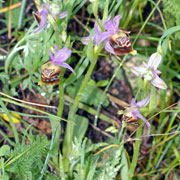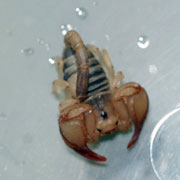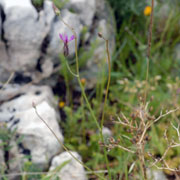Yesterday finished reasonably well and we hoped it was a sign that the weather was changing.
No such luck.
No dense cloud and mist this morning just good old fashioned rain and it was fairly cold about mid March temperatures for Britain. Today we had planned to climb Monte Sacro but had to make some contingency plans because climbing mountains, particularly those with exposed limestone which is very slippery when wet, is no fun in the rain and mist and can be dangerous. We has arranged to meet a distinguished Italian botanist Giovanni Quitadamo who would point us in the direction of some good plants but also try to sell us copies of his orchid book Orchidee Spantanee nel Parco Nazionale del Gargano.
Reluctantly we decided not to risk climbing Monte Sacro but first went to meet our expert friend. I bought a copy because I collect illustrated botanical books but perhaps to the rest 20 Euros is rather a lot to pay for a rather specialised book on the Orchids of the Gargano. In the event he grumbled that he had only sold three.
More Orchids at Coppa rotunda: Stop 1
This first stop was one of most precarious. We had to climb a short steep path and then duck under some barbed wire onto a hillside with few discernible pathways. The reward was four new orchids starting with Ophrys apulica (Apulian Ophrys) yet another insect mimicking Orchid. Nearby we found some small Serapias parviflora (Small-flowered Tongue-orchid) just about in flower and even better, Serapias lingua (Tongue Orchid). Serapias have very occasionally been reported in Britain but there are only two reported sites: one in Kent and one on the Lizard in Cornwall and it is suspected that at least one of these was planted. If you are keen on orchids and would like to see these very different looking members of the Orchidaceae then you must travel to Europe. Tongue Orchids don't open to reveal great colours or shapes and to distinguish them you need to look carefully into the interior of the flower.
There are two small dark lumps at the back of the flower in Serapias parviflora and only one in Serapias lingua but unless the flower is open sufficiently you can't even see these properly much less photograph them. The Serapias parviflora though usually has a quite small "tongue" and the one in the photograph shows exactly why they are known as Tongue Orchids. Also on the hillside there was more of the Onobrychis saxatile which we found at the Pulsano monastery and a tall plant with small purple flower looking like a weedy sort of Serratula tinctoria (Saw-wort). This plant was Crupina crupinastrum (Crupina) which we subsequently found in one or two other locations on the Gargano as well. The final Orchid was one of those variations on a theme of Ophrys lutea (Yellow Orchid).
This time the lower petal was almost entirely covered in dark brown pigment with only a rim left for a little yellow border. This orchid was named as Ophrys melena (Yellow Orchid) and as I took photos of this we also found an Orange Tip (Anthocharis cardamines) too cold to fly away, resting on another O. melena. Near the Ophrys melena were several Ophrys fusca which glories in the name of Dull Orchid but I really can't think why. It isn't much duller than Ophrys incubacea (Dark Ophrys) a few of which were also found nearby along with a one or two rather wet examples of Orchid quadripunctata (Four-spotted Orchid).
In the gloom and the rain flowers were not the best choice for naturalists and some of our party were as interested in the invertebrates as anything and had started looking in dark corners and under stones. They found this a very small Scorpion (Buthus occitanicus) which which looked fairly harmless being so small. However to quote the web site Bugsinhyperspace:
"....with small claws and a thick tail, this a very venomous species, typical of the Scorpion family Buthidae. In Europe there is a less venomous brown morph of this species, while the yellow morph pictured here originates in Africa and is among the most poisonous species in the world."
Although not as poisonous as its African counterpart, this scorpion could still be deadly to the young and elderly (me).
All these photos were taken on a dismal day with slight rain falling off and on throughout. After seeing these plants we retired to the vans and found a cafe in which to spend some time as botanising in the gloom and rain is not much good for seeing the flowers and certainly hopeless for photography.
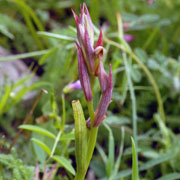
|
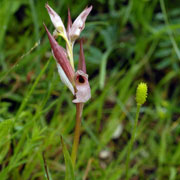
|
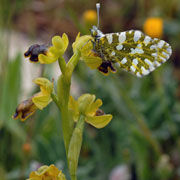
|
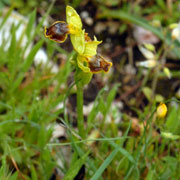
|
| Serapias parviflora Small-flowered Tongue-orchid | Serapias lingua Tongue Orchid | Anthocharis cardamines Orange tip on Ophrys melena | Ophrys melena Yellow Orchid |
Mostly Birds at the Coast: Stops 2 and 3
After an extended lunch hoping the rain would ease, we travelled to the coast just to see what we could find and stopped by some coastal marshes. At first I continued botanising and found Crepis rubra (Pink Hawk's-beard) and some Malva neglecta (Dwarf Mallow). Our bird expert though set up his telescope at both sites and started to show people the birds of the area including Marsh Harrier (Circus aeruginosus) and Purple Heron (Ardea purpurea)with its snake-like neck. There was a Common Sandpiper (Actitis hypoleucos) in a ditch nearby, a White Wagtail (Motacilla alba) and a few people saw or heard a Hoopoe (Upupa epops). While driving from one place to the other we saw several Little Egrets (Egretta garzetta) from the minibus window.
At the Salines (Salt lakes) there was small flock of pink Greater Flamingos (Phoenicopterus roseus). The Greater Flamingos looked good through my small binoculars but even better through the birding telescope. Just as I peered through the telescope one opened its wings to reveal the contrasting black edges. A discussion ensued about how this bird could have evolved to have its knees on back-to-front but our expert explained (patiently) that those knees were actually were ankles, the knees were higher up nearer its body and hidden from view. So they were really the right way round. In Roman times of course Flamingo tongues were a delicacy and even up to thirty years ago both Flamingos and their eggs were eaten by people in southern Europe. According to one of our greatest writers of children's stories Flamingos were used in more recent times as croquet mallets. Not many people know these things.
Near the Flamingos a Spoonbill (Platalea leucorodia) was feeding by dragging its bill from side to side in the water. We also saw an Avocet (Recurvirostra avosetta) and some Slender-billed Gulls (Chroicocephalus genei). Just by chance I had my binoculars in the right place at the right time when a Black-winged Stilt (Himantopus himantopus) flew by and I got a superb view of the bird in flight with its long red legs trailing behind it. It was just a shame that birds are so difficult to photograph without carrying hefty equipment to every site. We may have missed out on the plants today but the birds made up for that.
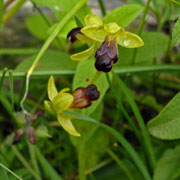
|
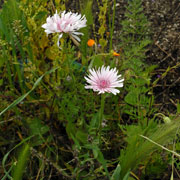
|
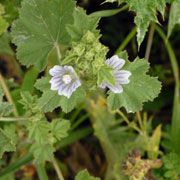
|
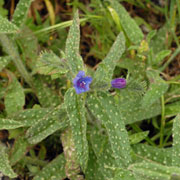
|
| Ophrys fusca Dull Orchid | Crepis rubra Pink Hawk's-beard | Malva neglecta Dwarf Mallow | Anchusa or Echium sp?? Unknown Bugloss |
It was beginning to look as though the weather had settled in this un-Italian pattern and although we hoped to climb Monte Sacro on Wednesday nothing could be certain. This would be our last chance for on Thursday we have to travel across the Gargano, botanising as we go, to our new Hotel at Peschici on the coast.


